Abstract
Restriction endonuclease analysis of human genomic DNA has previously revealed several prominent repeated DNA families defined by regularly spaced enzyme recognition sites. One of these families, termed alpha satellite DNA, was originally identified as tandemly repeated 340- or 680-base pair (bp) EcoRI fragments that hybridize to the centromeric regions of human chromosomes. We have investigated the molecular organization of alpha satellite DNA on individual human chromosomes by filter hybridization and in situ hybridization analysis of human DNA and DNA from rodent/human somatic cell hybrids, each containing only a single human chromosome. We used as probes a cloned 340-bp EcoRI alpha satellite fragment and a cloned alpha satellite-containing 2.0-kilobase pair (kbp) BamHI fragment from the pericentromeric region of the human X chromosome. In each somatic cell hybrid DNA, the two probes hybridized to a distinct subset of DNA fragments detected in total human genomic DNA. Thus, alpha satellite DNA on each of the human chromosomes examined--the X and Y chromosomes and autosomes 3, 4, and 21--is organized in a specific and limited number of molecular domains. The data indicate that subsets of alpha satellite DNA on individual chromosomes differ from one another, both with respect to restriction enzyme periodicities and with respect to their degree of sequence relatedness. The results suggest that some, and perhaps many, human chromosomes are characterized by a specific organization of alpha satellite DNA at their centromeres and that, under appropriate experimental conditions, cloned representatives of alpha satellite subfamilies may serve as a new class of chromosome-specific DNA markers.
Full text
PDF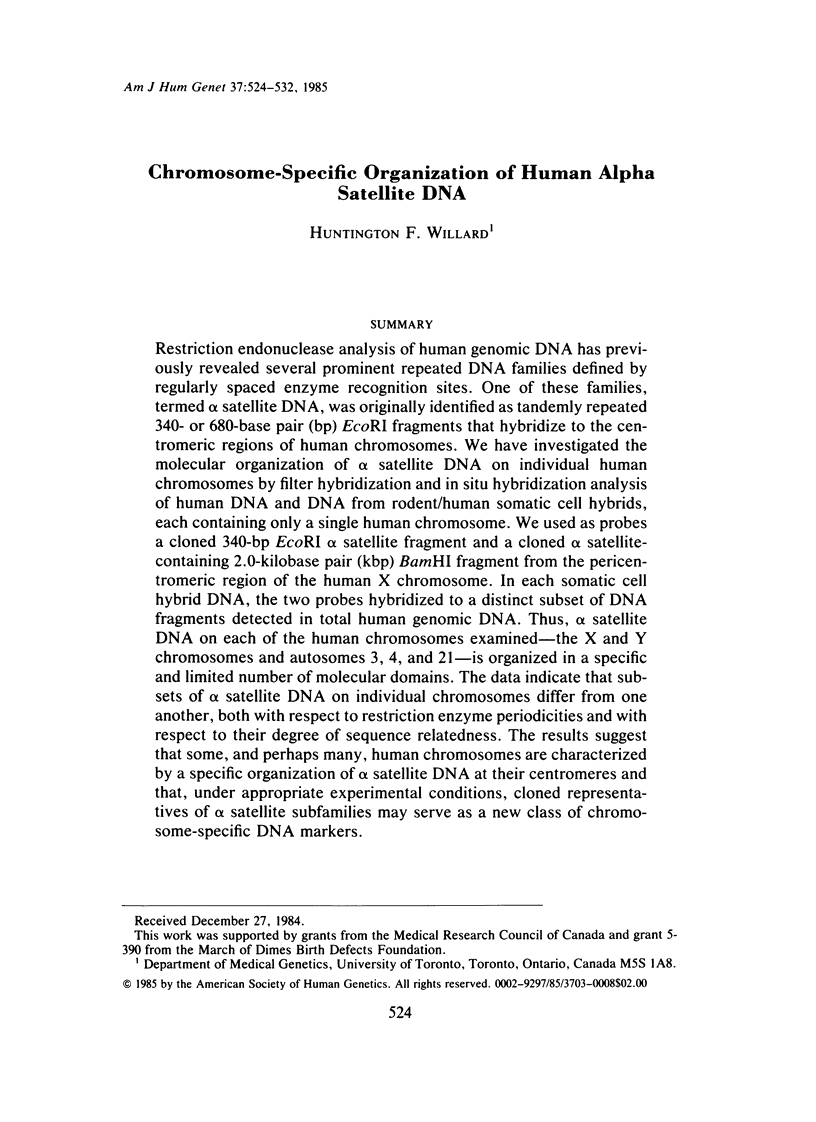
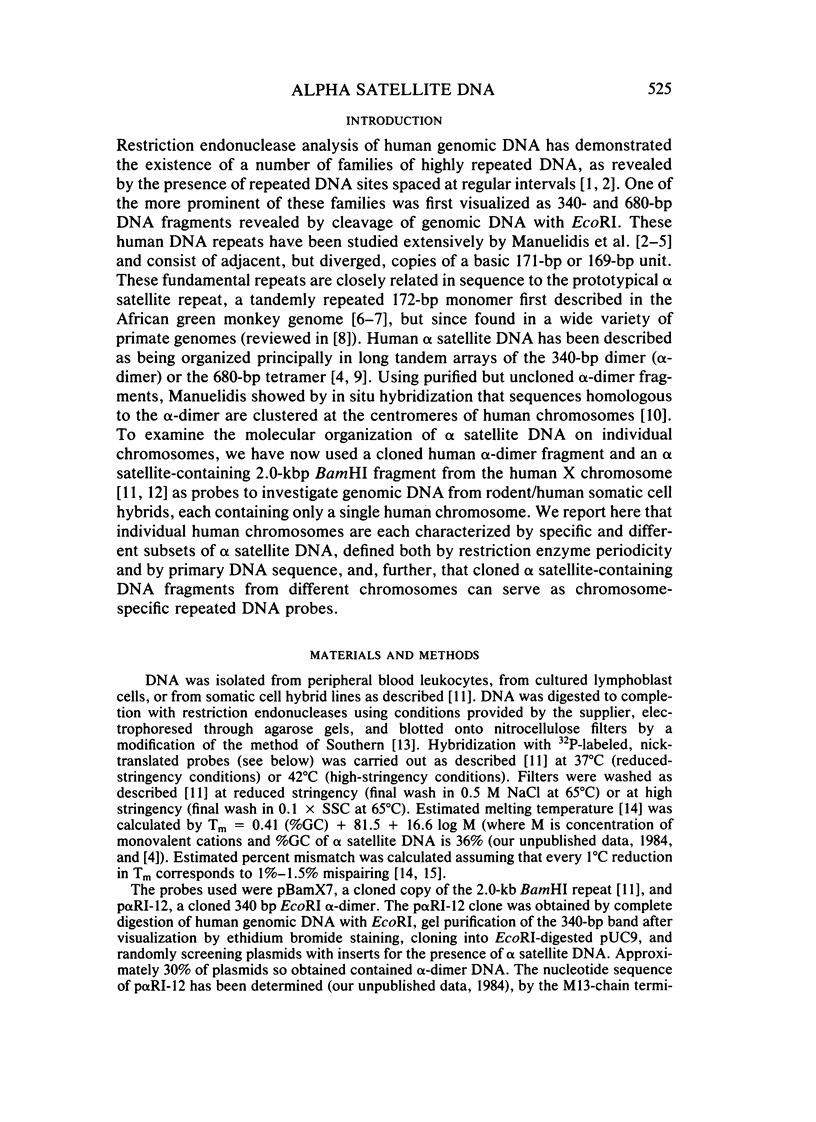
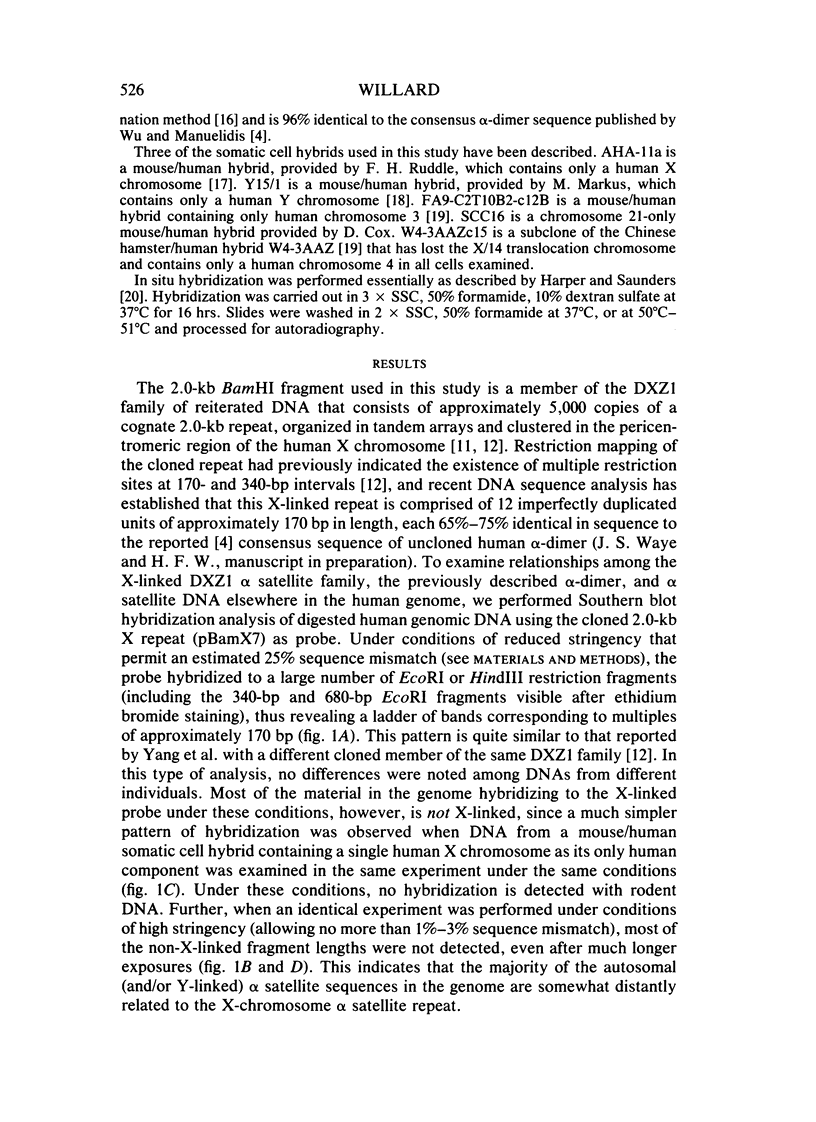
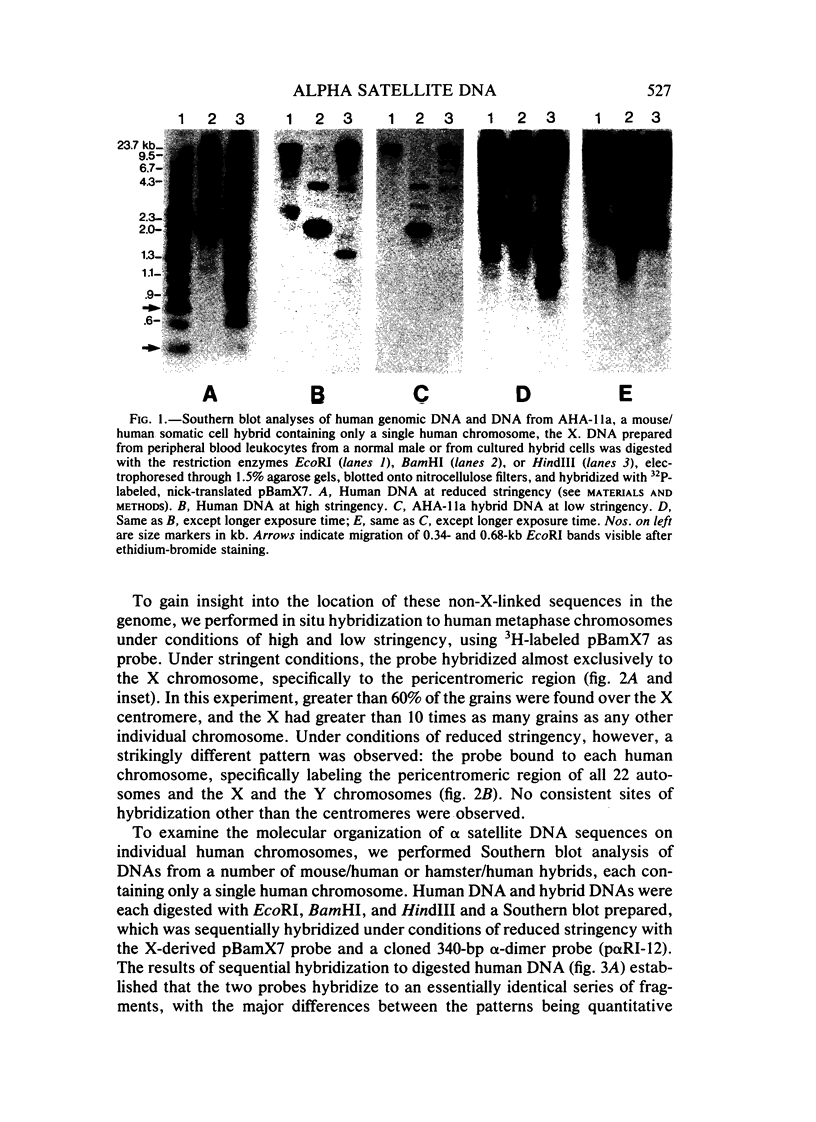
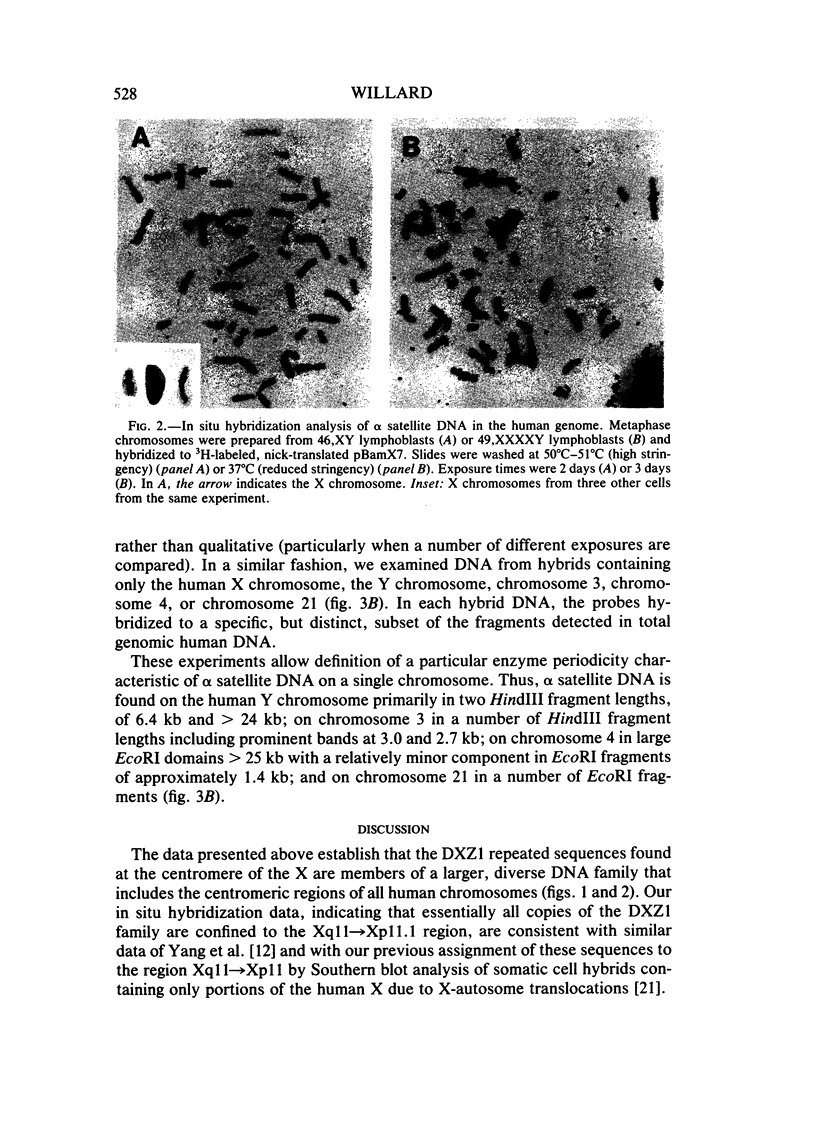

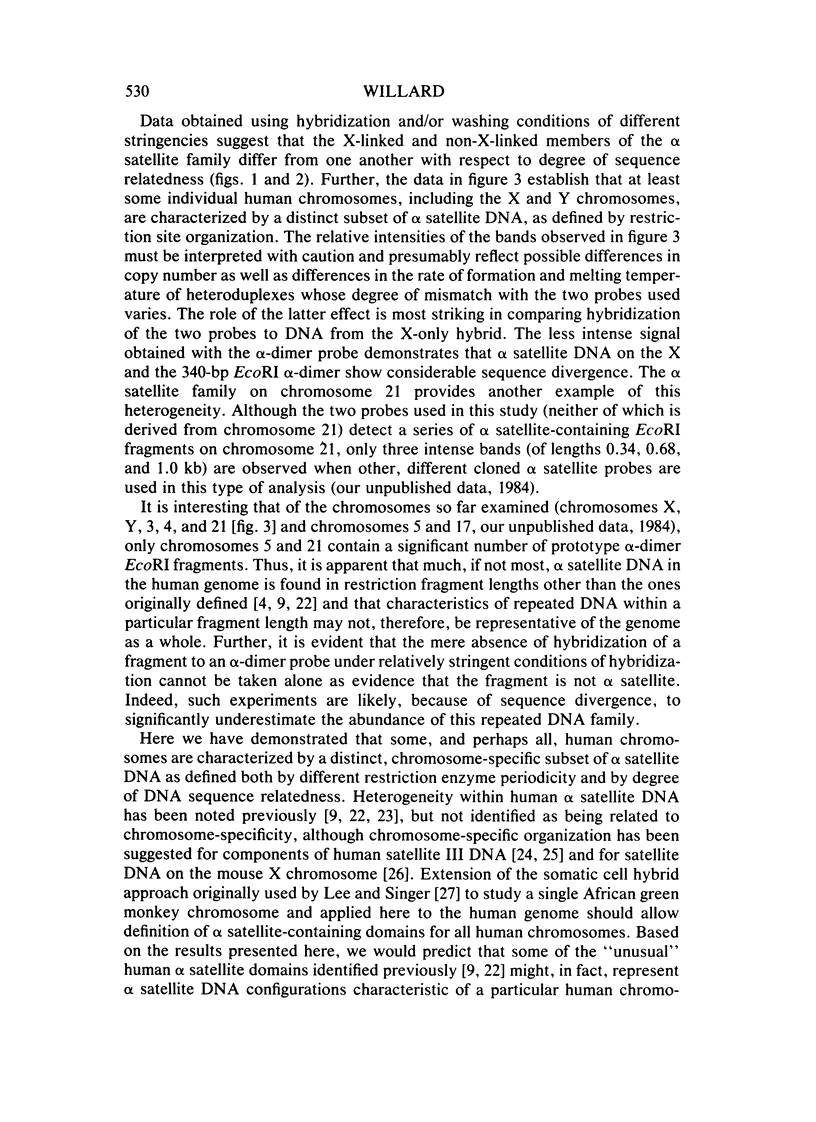
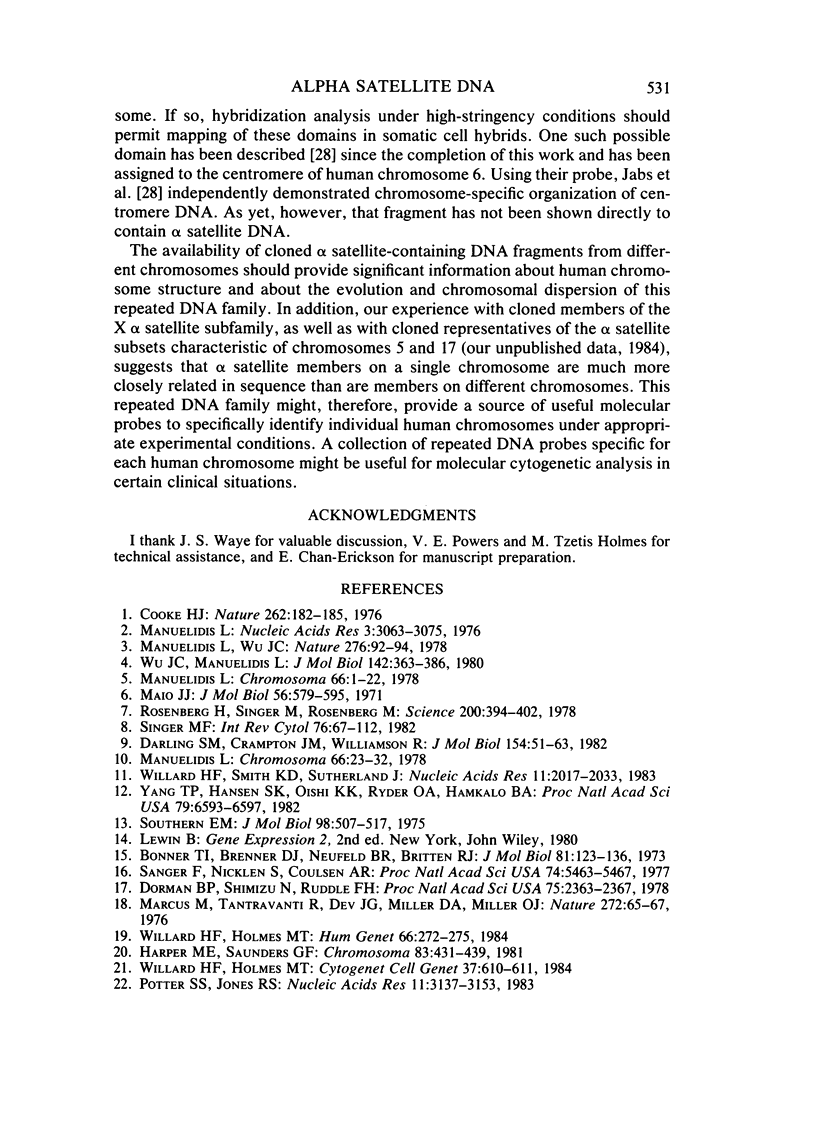
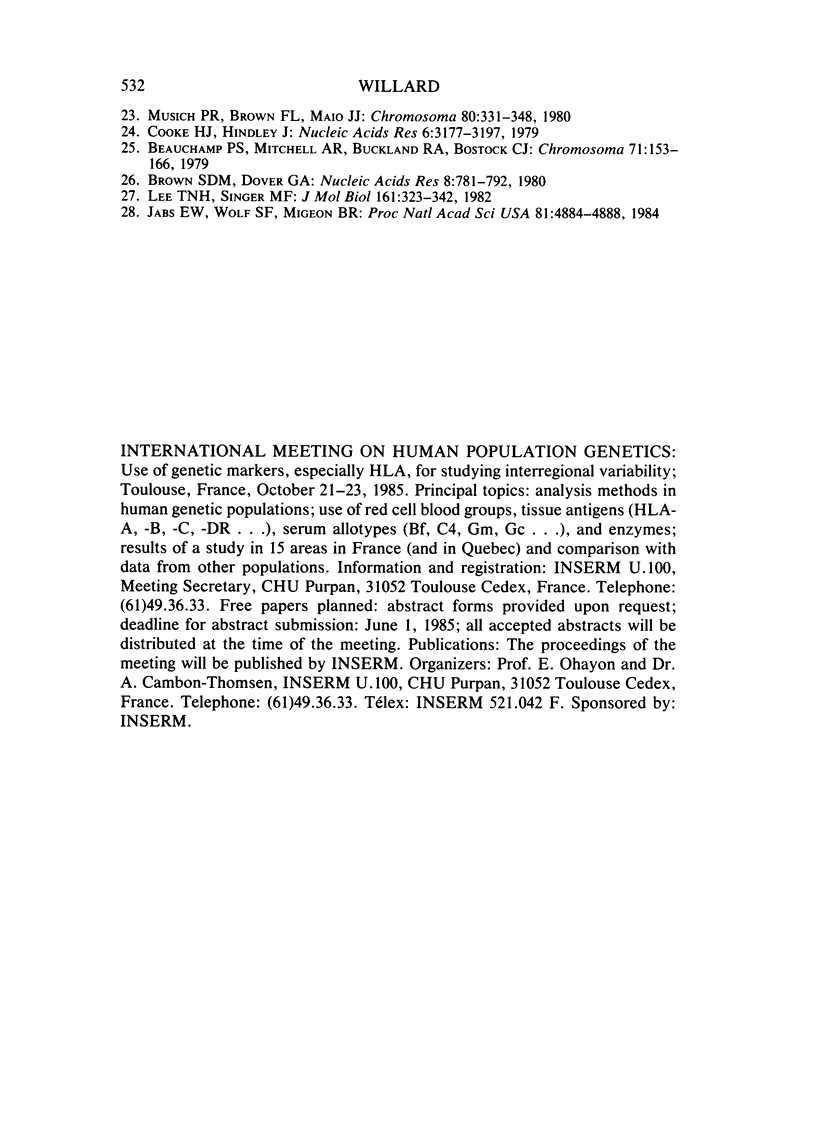
Images in this article
Selected References
These references are in PubMed. This may not be the complete list of references from this article.
- Beauchamp R. S., Mitchell A. R., Buckland R. A., Bostock C. J. Specific arrangements of human satellite III DNA sequences in human chromosomes. Chromosoma. 1979 Feb 21;71(2):153–166. doi: 10.1007/BF00292820. [DOI] [PubMed] [Google Scholar]
- Bonner T. I., Brenner D. J., Neufeld B. R., Britten R. J. Reduction in the rate of DNA reassociation by sequence divergence. J Mol Biol. 1973 Dec 5;81(2):123–135. doi: 10.1016/0022-2836(73)90184-8. [DOI] [PubMed] [Google Scholar]
- Brown S. D., Dover G. A. The specific organisation of satellite DNA sequences on the X-chromosome of Mus musculus: partial independence of chromosome evolution. Nucleic Acids Res. 1980 Feb 25;8(4):781–792. [PMC free article] [PubMed] [Google Scholar]
- Darling S. M., Crampton J. M., Williamson R. Organization of a family of highly repetitive sequences within the human genome. J Mol Biol. 1982 Jan 5;154(1):51–63. doi: 10.1016/0022-2836(82)90416-8. [DOI] [PubMed] [Google Scholar]
- Dorman B. P., Shimizu N., Ruddle F. H. Genetic analysis of the human cell surface: antigenic marker for the human X chromosome in human-mouse hybrids. Proc Natl Acad Sci U S A. 1978 May;75(5):2363–2367. doi: 10.1073/pnas.75.5.2363. [DOI] [PMC free article] [PubMed] [Google Scholar]
- Harper M. E., Saunders G. F. Localization of single copy DNA sequences of G-banded human chromosomes by in situ hybridization. Chromosoma. 1981;83(3):431–439. doi: 10.1007/BF00327364. [DOI] [PubMed] [Google Scholar]
- Jabs E. W., Wolf S. F., Migeon B. R. Characterization of a cloned DNA sequence that is present at centromeres of all human autosomes and the X chromosome and shows polymorphic variation. Proc Natl Acad Sci U S A. 1984 Aug;81(15):4884–4888. doi: 10.1073/pnas.81.15.4884. [DOI] [PMC free article] [PubMed] [Google Scholar]
- Lee T. N., Singer M. F. Structural organization of alpha-satellite DNA in a single monkey chromosome. J Mol Biol. 1982 Oct 25;161(2):323–342. doi: 10.1016/0022-2836(82)90156-5. [DOI] [PubMed] [Google Scholar]
- Maio J. J. DNA strand reassociation and polyribonucleotide binding in the African green monkey, Cercopithecus aethiops. J Mol Biol. 1971 Mar 28;56(3):579–595. doi: 10.1016/0022-2836(71)90403-7. [DOI] [PubMed] [Google Scholar]
- Manuelidis L., Wu J. C. Homology between human and simian repeated DNA. Nature. 1978 Nov 2;276(5683):92–94. doi: 10.1038/276092a0. [DOI] [PubMed] [Google Scholar]
- Musich P. R., Brown F. L., Maio J. J. Highly repetitive component alpha and related alphoid DNAs in man and monkeys. Chromosoma. 1980;80(3):331–348. doi: 10.1007/BF00292688. [DOI] [PubMed] [Google Scholar]
- Potter S. S., Jones R. S. Unusual domains of human alphoid satellite DNA with contiguous non-satellite sequences: sequence analysis of a junction region. Nucleic Acids Res. 1983 May 25;11(10):3137–3153. doi: 10.1093/nar/11.10.3137. [DOI] [PMC free article] [PubMed] [Google Scholar]
- Rosenberg H., Singer M., Rosenberg M. Highly reiterated sequences of SIMIANSIMIANSIMIANSIMIANSIMIAN. Science. 1978 Apr 28;200(4340):394–402. doi: 10.1126/science.205944. [DOI] [PubMed] [Google Scholar]
- Sanger F., Nicklen S., Coulson A. R. DNA sequencing with chain-terminating inhibitors. Proc Natl Acad Sci U S A. 1977 Dec;74(12):5463–5467. doi: 10.1073/pnas.74.12.5463. [DOI] [PMC free article] [PubMed] [Google Scholar]
- Singer M. F. Highly repeated sequences in mammalian genomes. Int Rev Cytol. 1982;76:67–112. doi: 10.1016/s0074-7696(08)61789-1. [DOI] [PubMed] [Google Scholar]
- Southern E. M. Detection of specific sequences among DNA fragments separated by gel electrophoresis. J Mol Biol. 1975 Nov 5;98(3):503–517. doi: 10.1016/s0022-2836(75)80083-0. [DOI] [PubMed] [Google Scholar]
- Willard H. F., Holmes M. T. A sensitive and dependable assay for distinguishing hamster and human X-linked steroid sulfatase activity in somatic cell hybrids. Hum Genet. 1984;66(2-3):272–275. doi: 10.1007/BF00286615. [DOI] [PubMed] [Google Scholar]
- Wu J. C., Manuelidis L. Sequence definition and organization of a human repeated DNA. J Mol Biol. 1980 Sep 25;142(3):363–386. doi: 10.1016/0022-2836(80)90277-6. [DOI] [PubMed] [Google Scholar]
- Yang T. P., Hansen S. K., Oishi K. K., Ryder O. A., Hamkalo B. A. Characterization of a cloned repetitive DNA sequence concentrated on the human X chromosome. Proc Natl Acad Sci U S A. 1982 Nov;79(21):6593–6597. doi: 10.1073/pnas.79.21.6593. [DOI] [PMC free article] [PubMed] [Google Scholar]





